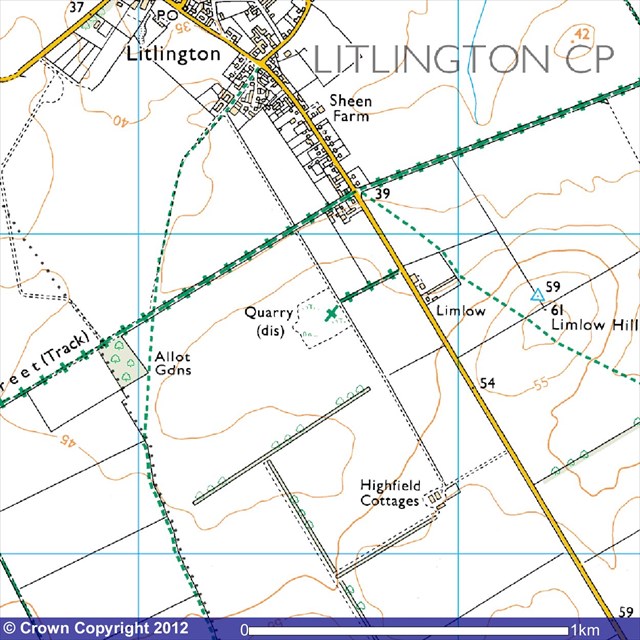
Image produced from the Ordnance Survey Get-a-map service. Image reproduced
with kind permission of Ordnance Survey and Ordnance Survey of Northern Ireland.
This earthcache has been developed with the kind permission of the landowner, Mr R Parker. Cachers are reminded that Litlington Pit is an important wildlife habitat and accordingly the site should be treated with respect. You are free to wander around the site, but dogs must be kept on lead if livestock is grazing and care should be taken especially close to the rock face.
In this earthcache you are going to learn about the classification and uses of the rock known locally as clunch.
The simplest classification of rock types is into igneous, sedimentary and metamorphic types. Igneous (from the Latin igneus 'of fire') rocks are formed when molten magma from deep within the Earth cools and solidifies. Igneous rocks usually contain a variety of distinct crystals. If the magma is erupted from the surface, it cools quickly, causing small crystals to form. Magma that is intruded into fissures within the bedrock cools more slowly, allowing much larger crystals to form. In either case, many of these mineral crystals will have smooth surfaces that catch the light, giving a fresh surface of the rock a sparkly appearance.
Sedimentary rocks are formed by the gradual accumulation of particles, either in the form of mineral compounds precipitating out of solution or fine grains that are transported to a location and then deposited. Sedimentary rocks usually do not contain large crystals and often have a dull, matte appearance on fresh surfaces. However, sediments often have distinct layers, showing how the deposit has built up over time, in a similar way to the rings in a tree showing its growth. Sedimentary rocks may also contain fossils, which are the remains of living organisms that lived and died as the rock was being laid down.
Metamorphic ('changing form') rocks are formed when geological processes involving a mixture of intense heat and pressure cause chemical and physical changes to a pre-existing rock type. Igneous, sedimentary and metamorphic rocks may all undergo subsequent metamorphic change and this changes the character of the original rock. Since metamorphic rocks can be formed from any rock type, they can exhibit a wide variety of characterstics, but often display a reasonably uniform texture with fine crystallisation evident. Metamorphism of a sedimentary rock usually obliterates all signs of fossils.
Your Task:
1) There is plenty of rock spoil on the ground near the base of the exposed rock face. Inspect the fragments and decide whether the clunch quarried here is igneous, sedimentary or metamorphic.
2) Clunch was sometimes extracted for use as a building material. Describe the texture and strength of the clunch fragments and describe how well suited you think it is to building.
3) Chemically, clunch is mainly calcium carbonate. A common field test for calcium carbonate is to place a few drops of dilute hydrochloric acid on a sample; household vinegar (ethanoic acid) works as a reasonable substitute. Either go to the cache site prepared or take a small sample of the rock spoil home and add a couple of drops of acid. Look carefully and describe the effect, if any, the acid has on the clunch.
4) Much of the clunch extracted here was probably burnt to make it undergo thermal decomposition. In this process, carbon dioxide is released to leave a useful white compound called calcium oxide. This process is represented in the equation below:

Find out the common name for calcium oxide and list some uses of this compound.
|
Answers should be emailed to me: please note that I am unlikely to respond to your message unless you check "I want to send my email address along with this message". Please do NOT use the awful Messaging Centre system to contact me.
Please do not attempt to climb on or take samples from the exposed rock faces. These are delicate and potentially dangerous. Instead there is plenty of spoil at the base of the rock face that can be safely inspected.
Take time to read the information board at the site to find out a little more about the quarry and its importance as a habitat. It is also possible to walk around the quarry to the higher ground immediately to the west which gives some nice views over the surrounding area. From here it is possible to appreciate the rolling landscape and, in particular, the distinctive colour given to the soil by the local bedrock.
FTF: JF20938